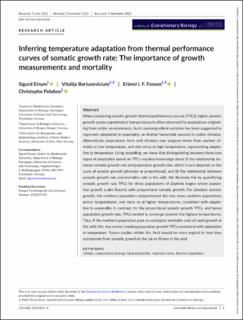| dc.contributor.author | Einum, Sigurd | |
| dc.contributor.author | Bartuseviciute, Vitalija | |
| dc.contributor.author | Fossen, Erlend Ignacio Fleck | |
| dc.contributor.author | Pelabon, Christophe | |
| dc.date.accessioned | 2023-01-17T13:17:20Z | |
| dc.date.available | 2023-01-17T13:17:20Z | |
| dc.date.created | 2022-12-13T10:28:57Z | |
| dc.date.issued | 2022 | |
| dc.identifier.issn | 1010-061X | |
| dc.identifier.uri | https://hdl.handle.net/11250/3044056 | |
| dc.description.abstract | When comparing somatic growth thermal performance curves (TPCs), higher somatic growth across experimental temperatures is often observed for populations originating from colder environments. Such countergradient variation has been suggested to represent adaptation to seasonality, or shorter favourable seasons in colder climates. Alternatively, populations from cold climates may outgrow those from warmer climates at low temperature, and vice versa at high temperature, representing adaptation to temperature. Using modelling, we show that distinguishing between these two types of adaptation based on TPCs requires knowledge about (i) the relationship between somatic growth rate and population growth rate, which in turn depends on the scale of somatic growth (absolute or proportional), and (ii) the relationship between somatic growth rate and mortality rate in the wild. We illustrate this by quantifying somatic growth rate TPCs for three populations of Daphnia magna where population growth scales linearly with proportional somatic growth. For absolute somatic growth, the northern population outperformed the two more southern populations across temperatures, and more so at higher temperatures, consistent with adaptation to seasonality. In contrast, for the proportional somatic growth TPCs, and hence population growth rate, TPCs tended to converge towards the highest temperatures. Thus, if the northern population pays an ecological mortality cost of rapid growth in the wild, this may create crossing population growth TPCs consistent with adaptation to temperature. Future studies within this field should be more explicit in how they extrapolate from somatic growth in the lab to fitness in the wild. | en_US |
| dc.language.iso | eng | en_US |
| dc.publisher | Wiley | en_US |
| dc.rights | Navngivelse 4.0 Internasjonal | * |
| dc.rights.uri | http://creativecommons.org/licenses/by/4.0/deed.no | * |
| dc.title | Inferring temperature adaptation from thermal performance curves of somatic growth rate: The importance of growth measurements and mortality | en_US |
| dc.type | Journal article | en_US |
| dc.type | Peer reviewed | en_US |
| dc.description.version | publishedVersion | en_US |
| dc.rights.holder | Copyright 2022 The Author(s) | en_US |
| cristin.ispublished | true | |
| cristin.fulltext | original | |
| cristin.qualitycode | 2 | |
| dc.identifier.doi | 10.1111/jeb.14136 | |
| dc.identifier.cristin | 2092387 | |
| dc.source.journal | Journal of Evolutionary Biology | en_US |
| dc.relation.project | Norges forskningsråd: 223257 | en_US |
| dc.identifier.citation | Journal of Evolutionary Biology. 2022 | en_US |

